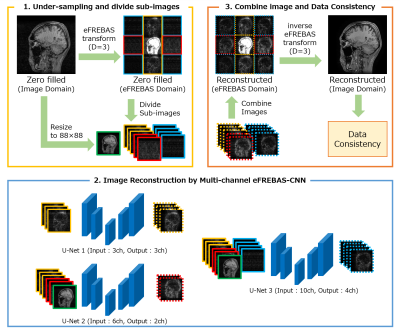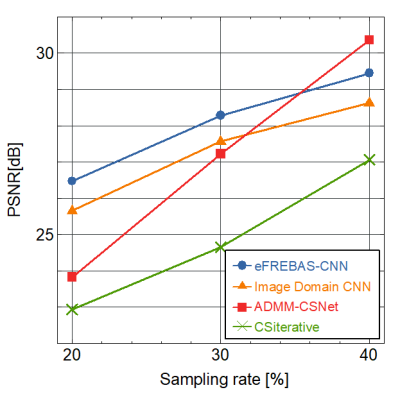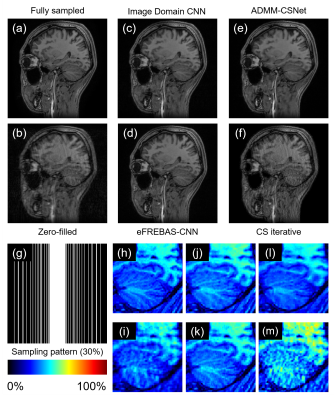1750
Multi-channel and multi-group-based CNN Image Reconstruction using Equal-sized Multi-resolution Image Decomposition1Utsunomiya University, Utsunomiya, Japan
Synopsis
CNN based Compressed Sensing reconstruction has attracted much attention. It is difficult to restore higher spatial frequency components even with CNN-CS. We proposed a new transformed image domain CNN-CS method based on equal-sized multi-resolution image decomposition (eFREBAS transform). The eFREBAS transform is multi resolution analysis method that divide the image into equal-sized sub-images. This CNN consisting of three U-Net CNNs, each with multi-channel input and output reconstructs MR phase varied images in frequency band-to-band through estimating artifact-free sub-images from under-sampled sub-images. Reconstruction experiments showed that eFREBAS-CNN could reconstruct sharp images that have strong phase variation.
Introduction
Recently, it has been reported that CNN-CS outperforms traditional CS iterative method (CS-MRI) in terms of image quality and reconstruction time. In CS-MRI using CNN, it is difficult to restore the fine structure of images since their information are lost in signal acquisition stage. In this study, a new transformed image domain CNN-CS method based on equal-sized multi-resolution image decomposition (eFREBAS transform) [1] was used to restore the detail of images since there are similarity among decomposed sub-images, eFREBAS based CNN consists of three U-Net CNNs, each with multi-channel input and output of eFREBAS sub-images. Proposed method was applied to spatially phase varied images and compared with preceding methods.Method
A multi-resolution analysis method based on dual type Fresnel transform (eFREBAS transform) that allows optional scaling of images was used in this study. Let D be a scaling parameter, the input images are decomposed into $$$D^2$$$ sub-images having the same scale size (1/D). Figure 1 shows an example of eFREBAS transformed images using D = 3, 5. The characteristics of the object structure are decomposed into sub-images and those sub- images resemble each other. Figure 2 (b), (c) show the eFREBAS transformed images before and after random under-sampling for horizontal direction in k-space. Some information was lost in sub-images corresponding to higher bands due to the under-sampling. Considering the similarity of decomposed sub-image by eFREBAS, proposed eFREBAS-CNN consists of three U-Net CNNs, each with multi-channel input and output. In this study, we set D to 3. As shown in Fig.2, sub-images after under-sampling were divided three groups according to their closeness to the fully sampled sub-images. Three groups were reconstructed by three CNNs, respectively. The network architecture and reconstruction flow are shown in Fig.3. Since sub-images of Group B and Group C have small information about the object image, lower band sub-images (yellow images) were used together to restore higher band sub-images. In addition, the absolute under-sampled image of the image domain (green image) were used as the input image of U-Net2 and U-Net3 to give the information about object structure for those CNNs. We assumed that the images size was $$$256\times256$$$ pixels and all images were filled with zeros at both ends of the k-space to produce $$$264\times264$$$ pixels to produce $$$88\times88$$$ pixels sub-images by eFREBAS transform. The reconstructed image cut the zero filled area in k-space to produce $$$256\times256$$$ pixels. Finally, Data Consistency step was applied to reconstructed image to reduce the mean squared error in the k-space.Results and Discussion
In the experiments, 30 T1-weighted (T1W) and 5 T2-weighted (T2W) phase varied images of a head were used. Those images were collected from healthy volunteers using a Canon Medical Systems 3T MRI scanner. In the training and testing, 25 T1W images were used for training and 10 T1W/T2W images were used for testing. All eFREBAS domain sub-images were separated into real and imaginary parts before inputting them into the CNN. Therefore, all CNNs ran twice to reconstruct the real and the imaginary part of the image, respectively. We compared the peak-signal-to-noise ratio (PSNR) of obtained images with other reconstruction methods; U-Net based single CNN reconstruction using image domain (called Image Domain CNN), ADMM-CSNet [2], and an iterative optimization method (CS iterative) [3]. Figure 4 shows the PSNRs of the reconstructed images. The PSNR of eFREBAS-CNN shows highest value in 20% and 30% sampling rates. Figure 5 shows the reconstructed images when the 30% cartesian random under-sampling pattern was used. All CNN based methods could remove most of the aliasing artifacts observed in (b). In addition, eFREBAS-CNN could reconstruct the structure of object images with most accurately and sharply. The time required for training / testing with GPU for eFREBAS-CNN, Image Domain CNN and ADMM-CSNet were 0.65 h / 0.159 s, 0.5 h / 0.036 s and 9.5 h / 1.06 s, respectively. As shown in Fig.4 and 5, fine structure preservation is improved in proposed eFREBAS-CNN compared to other methods especially for a 20-30% low sampling rate. This attribute to the fact that each U-Net worked for different tasks according to the components of sub-images. For example, U-Net1 mainly worked to eliminate aliasing artifacts, while U-Net2 and U-Net3 worked to predict the higher frequency components of the subject image. Since divided sub-images correspond to different spatial frequency bands, proposed eFREBAS-CNN enabled to predict subject images in frequency band-to-band. These features contributed to restore the fine structure of images and to improve the PSNR of images.Conclusion
Proposed multi-channel and multi-group-based CNN obtained from multi-resolution image decomposition could improve the image quality of CNN-CS for spatially varied phase images.Acknowledgements
This work was supported in part by JSPS KAKENHI grants 19K04423 and the KAYAMORI Foundation of Informational Science Advancement. We would like to thank Canon Medical Systems.References
- S.Ito et al., Multiresolution Image analysis using dual Fresnel transform Pairs and Application to Medical Image Denoising, IEEE International Conference on Image Processing 2003, Barcelona, Spain, Map8.7.
- Y.
Yang et al., ADMM-CSNet: A Deep Learning Approach for Image Compressive
Sensing, IEEE Tran PAMI 2020, 42: 521-538.
- F. Zhao et al., Separate Magnitude and Phase Regularization via Compressed Sensing, IEEE Tran Med Imag 2012, 31: 1713-1723.
Figures

Fig.1 Examples of the eFREBAS transform: (a) original image of image domain, (b) eFREBAS domain image D=3, (c) eFREBAS domain image D=5. All images are absolute images.



